Marco Moretti
Parametric Near-Field MMSE Channel Estimation for sub-THz XL-MIMO Systems
Apr 14, 2025Abstract:Accurate channel estimation is essential for reliable communication in sub-THz extremely large (XL) MIMO systems. Deploying XL-MIMO in high-frequency bands not only increases the number of antennas, but also fundamentally alters channel propagation characteristics, placing the user equipments (UE) in the radiative near-field of the base station. This paper proposes a parametric estimation method using the multiple signal classification (MUSIC) algorithm to extract UE location data from uplink pilot signals. These parameters are used to reconstruct the spatial correlation matrix, followed by an approximation of the minimum mean square error (MMSE) channel estimator. Numerical results show that the proposed method outperforms the least-squares (LS) estimator in terms of the normalized mean-square error (NMSE), even without prior UE location knowledge.
Power Minimization with Rate Constraints for Multi-User MIMO Systems with Large-Size RISs
Oct 06, 2024



Abstract:This study focuses on the optimization of a single-cell multi-user multiple-input multiple-output (MIMO) system with multiple large-size reconfigurable intelligent surfaces (RISs). The overall transmit power is minimized by optimizing the precoding coefficients and the RIS configuration, with constraints on users' signal-to-interference-plus-noise ratios (SINRs). The minimization problem is divided into two sub-problems and solved by means of an iterative alternating optimization (AO) approach. The first sub-problem focuses on finding the best precoder design. The second sub-problem optimizes the configuration of the RISs by partitioning them into smaller tiles. Each tile is then configured as a combination of pre-defined configurations. This allows the efficient optimization of RISs, especially in scenarios where the computational complexity would be prohibitive using traditional approaches. Simulation results show the good performance and limited complexity of the proposed method in comparison to benchmark schemes.
MMSE Design of RIS-aided Communications
Dec 13, 2023



Abstract:Consider a communication system in which a single antenna user equipment exchanges information with a multi-antenna base station via a reconfigurable intelligent surface (RIS) in the presence of spatially correlated channels and electromagnetic interference (EMI). To exploit the attractive advantages of RIS technology, accurate configuration of its reflecting elements is crucial. In this paper, we use statistical knowledge of channels and EMI to optimize the RIS elements for i) accurate channel estimation and ii) reliable data transmission. In both cases, our goal is to determine the RIS coefficients that minimize the mean square error, resulting in the formulation of two non-convex problems that share the same structure. To solve these two problems, we present an alternating optimization approach that reliably converges to a locally optimal solution. The incorporation of the diagonally scaled steepest descent algorithm, derived from Newton's method, ensures fast convergence with manageable complexity. Numerical results demonstrate the effectiveness of the proposed method under various propagation conditions. Notably, it shows significant advantages over existing alternatives that depend on a sub-optimal configuration of the RIS and are derived on the basis of different criteria.
Joint OAM Radar-Communication Systems: Target Recognition and Beam Optimization
May 11, 2022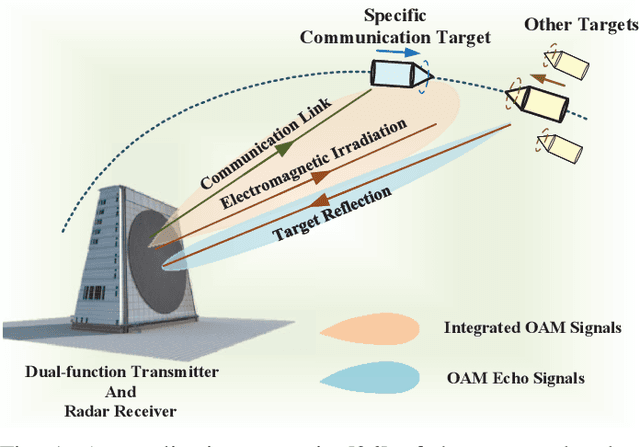
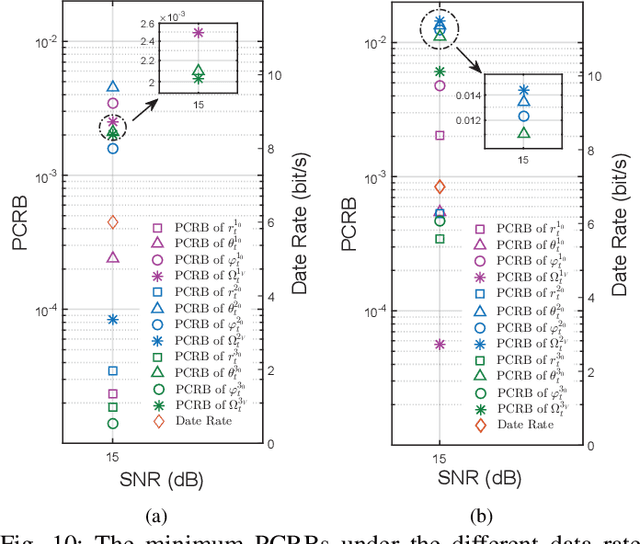

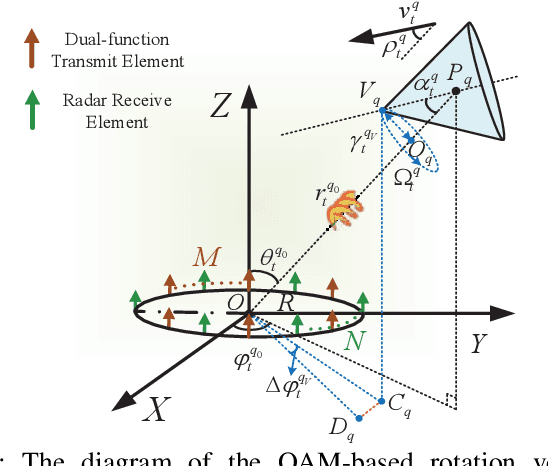
Abstract:Orbital angular momentum (OAM) radars are able to estimate the azimuth angle and the rotation velocity of multiple targets without relative motion or beam scanning. Moreover, OAM wireless communications can achieve high spectral efficiency (SE) by utilizing a set of information-bearing modes on the same frequency channel. Benefitting from the above advantages, in this paper, we design a novel radar-centric joint OAM radar-communication (RadCom) scheme based on uniform circular arrays (UCAs), which modulates information signals on the existing OAM radar waveform. In details, we first propose an OAM-based three-dimensional (3-D) super-resolution position estimation and rotation velocity detection method, which can accurately estimate the 3-D position and rotation velocity of multiple targets. Then, we derive the posterior Cramer-Rao bound (PCRB) of the OAM-based estimates and, finally, we analyze the transmission rate of the integrated communication system. To achieve the best trade-off between imaging and communication, the transmitted integrated OAM beams are optimized by means of an exhaustive search method. Both mathematical analysis and simulation results show that the proposed radar-centric joint OAM RadCom scheme can accurately estimate the 3-D position and rotation velocity of multiple targets while ensuring the transmission rate of the communication receiver, which can be regarded as an effective supplement to existing joint RadCom schemes.
Broadband beam steering for misaligned multi-mode OAM communication systems
Dec 01, 2021


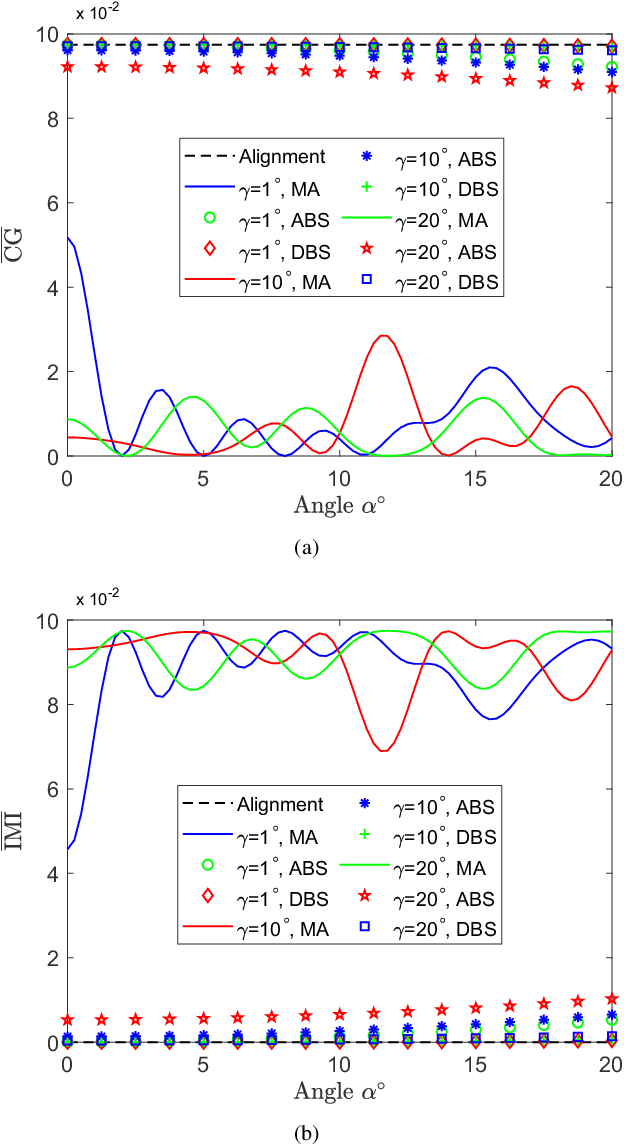
Abstract:Orbital angular momentum (OAM) at radio frequency (RF) has attracted more and more attention as a novel approach of multiplexing a set of orthogonal OAM modes on the same frequency channel to achieve high spectral efficiency (SE). However, the precondition for maintaining the orthogonality among different OAM modes is perfect alignment of the transmit and receive uniform circular arrays (UCAs), which is difficult to be satisfied in practical wireless communication scenario. Therefore, to achieve available multi-mode OAM broadband wireless communication, we first investigate the effect of oblique angles on the transmission performance of the multi-mode OAM broadband system in the non-parallel misalignment case. Then, we compare the UCA-based RF analog and baseband digital transceiver structures and corresponding beam steering schemes. Mathematical analysis and numerical simulations validate that the SE of the misaligned multi-mode OAM broadband system is quite low, while analog and digital beam steering both can significantly improve the SE of the system. However, digital beam steering can obtain higher SE than analog beam steering especially when the bandwidth and the number of array elements are large, which validates that baseband digital transceiver with digital beam steering is more suitable for multi-mode OAM broadband wireless communication systems in practice.
Radio-Frequency Multi-Mode OAM Detection Based on UCA Samples Learning
Nov 29, 2021



Abstract:Orbital angular momentum (OAM) at radio-frequency provides a novel approach of multiplexing a set of orthogonal modes on the same frequency channel to achieve high spectral efficiencies. However, classical phase gradient-based OAM mode detection methods require perfect alignment of transmit and receive antennas, which greatly challenges the practical application of OAM communications. In this paper, we first show the effect of non-parallel misalignment on the OAM phase structure, and then propose the OAM mode detection method based on uniform circular array (UCA) samples learning for the more general alignment or non-parallel misalignment case. Specifically, we applied three classifiers: K-nearest neighbor (KNN), support vector machine (SVM), and back-propagation neural network (BPNN) to both single-mode and multi-mode OAM detection. The simulation results validate that the proposed learning-based OAM mode detection methods are robust to misalignment errors and especially BPNN classifier has the best generalization performance.
Power Minimization of Downlink Spectrum Slicing for eMBB and URLLC Users
Oct 27, 2021
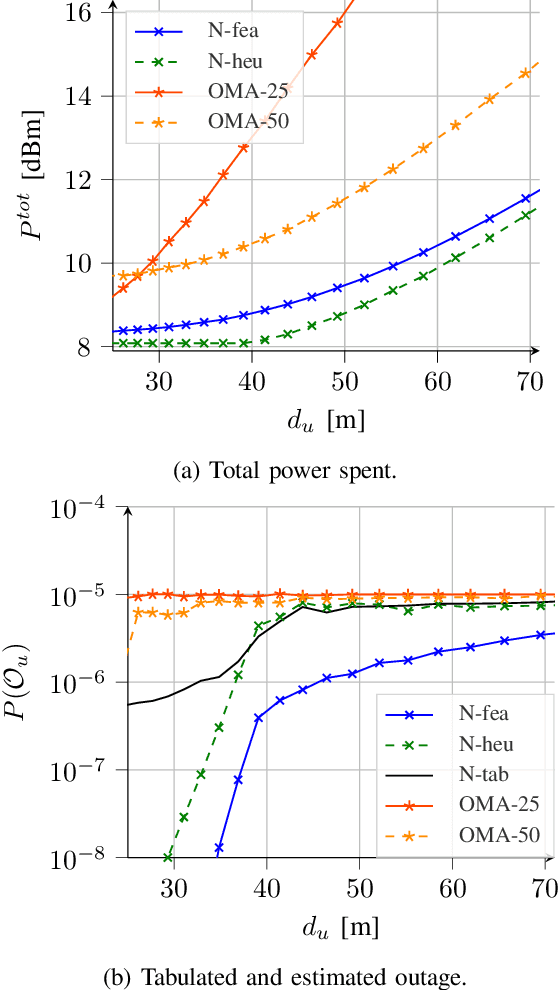


Abstract:5G technology allows the presence of heterogeneous services in the same physical network. On the radio access network (RAN), the spectrum slicing of the shared radio resources is a critical task to guarantee the performance of each service. In this paper, we analyze a downlink communication in which a base station (BS) should serve two types of traffic, enhanced mobile broadband (eMBB) and ultra-reliable low-latency communication (URLLC), respectively. Due to the nature of low-latency traffic, the BS knows the channel state information (CSI) of the eMBB users only. In this setting, we study the power minimization problem employing orthogonal multiple access (OMA) and non-orthogonal multiple access (NOMA) schemes. We analyze the impact of resource sharing, showing that the knowledge of eMBB CSI can be used also in resource allocation for URLLC users. Based on this analysis, we propose two algorithms: a feasible and a block coordinated descent approach (BCD). We show that the BCD is optimal for the URLLC power allocation. The numerical results show that NOMA leads to a lower power consumption compared to OMA, except when the URLLC user is very close to the BS. For the last case, the optimal approach depends on the channel condition of the eMBB user. In any case, even when the OMA paradigm attains the best performance, the gap with NOMA is negligible, proving the NOMA capacity in exploiting the shared resources to reduce the power consumption in every condition.
Joint Spatial Division and Coaxial Multiplexing for Downlink Multi-User OAM Wireless Backhaul
Oct 18, 2021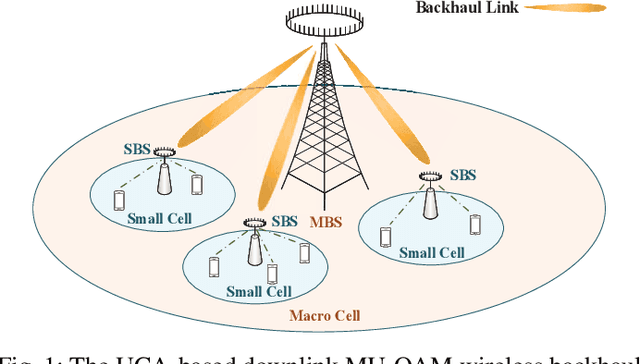

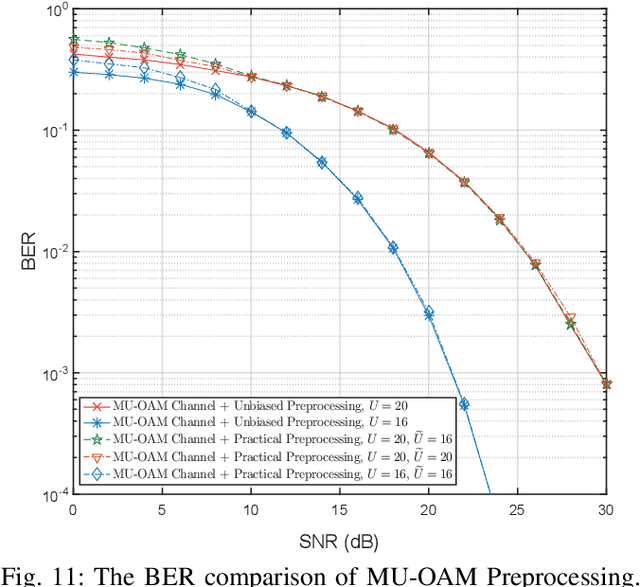
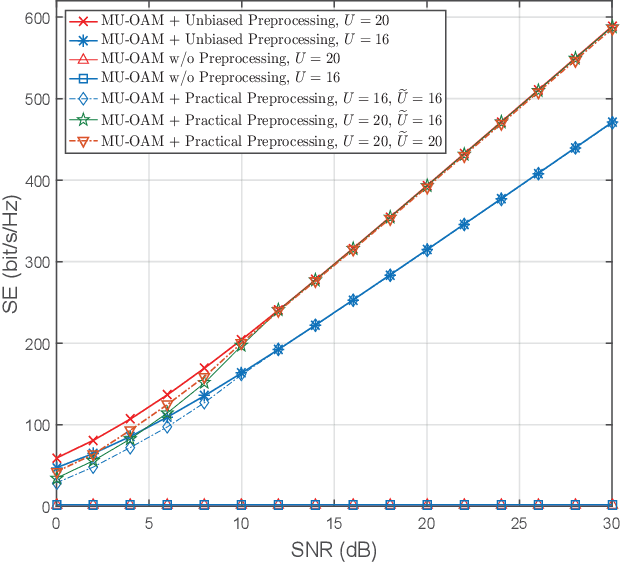
Abstract:Orbital angular momentum (OAM) at radio frequency (RF) provides a novel approach of multiplexing a set of orthogonal modes on the same frequency channel to achieve high spectral efficiencies (SEs). However, the existing research on OAM wireless communications is mainly focused on pointto-point transmission in the line-of-sight (LoS) scenario. In this paper, we propose an overall scheme of the downlink multi-user OAM (MU-OAM) wireless backhaul based on uniform circular arrays (UCAs) for broadcasting networks, which can achieve the joint spatial division and coaxial multiplexing (JSDCM). A salient feature of the proposed downlink MU-OAM wireless backhaul systems is that the channel matrices are completely characterized by the position of each small base station (SBS), independent of the numbers of subcarriers and antennas, which avoids estimating large channel matrices required by the traditional downlink multi-user multiple-input multiple-output (MU-MIMO) wireless backhaul systems. Thereafter, we propose an OAM-based multiuser distance and angle of arrival (AoA) estimation method, which is able to simultaneously estimate the positions of multiple SBSs with a flexible number of training symbols. With the estimated distances and AoAs, a MU-OAM preprocessing scheme is applied to eliminate the co-mode and inter-mode interferences in the downlink MU-OAM channel. At last, the proposed methods are extended to the downlink MU-OAM-MIMO wireless backhaul system equipped with uniform concentric circular arrays (UCCAs), for which much higher spectral efficiency (SE) and energy efficiency (EE) than traditional MU-MIMO systems can be achieved. Both mathematical analysis and simulation results validate that the proposed scheme can effectively eliminate both interferences of the practical downlink MU-OAM channel and approaches the performance of the ideal MU-OAM channel.
A Promising Technology for 6G Wireless Networks: Intelligent Reflecting Surface
Oct 18, 2021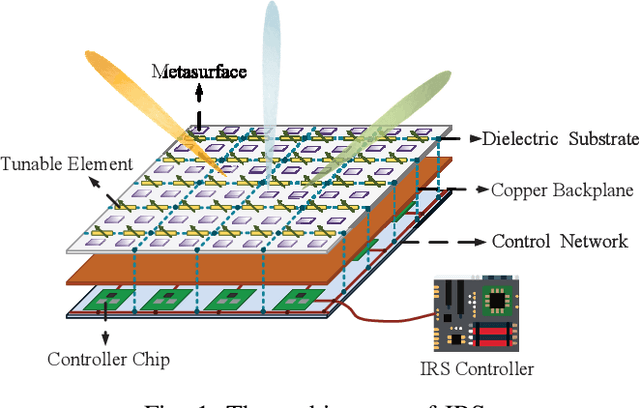
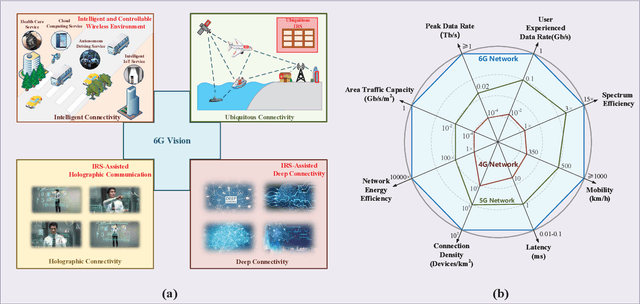

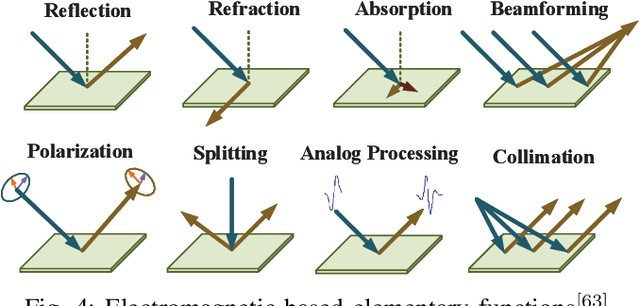
Abstract:The intelligent information society, which is highly digitized, intelligence inspired and globally data driven, will be deployed in the next decade. The next 6G wireless communication networks are the key to achieve this grand blueprint, which is expected to connect everything, provide full dimensional wireless coverage and integrate all functions to support full-vertical applications. Recent research reveals that intelligent reflecting surface (IRS) with wireless environment control capability is a promising technology for 6G networks. Specifically, IRS can intelligently control the wavefront, e.g., the phase, amplitude, frequency, and even polarization by massive tunable elements, thus achieving fine-grained 3-D passive beamforming. In this paper, we first give a blueprint of the next 6G networks including the vision, typical scenarios and key performance indicators (KPIs). Then, we provide an overview of IRS including the new signal model, hardware architecture and competitive advantages in 6G networks. Besides, we discuss the potential application of IRS in the connectivity of 6G networks in detail, including intelligent and controllable wireless environment, ubiquitous connectivity, deep connectivity and holographic connectivity. At last, we summarize the challenges of IRS application and deployment in 6G networks. As a timely review of IRS, our summary will be of interest to both researchers and practitioners engaging in IRS for 6G networks.
AoA Estimation for OAM Communication Systems With Mode-Frequency Multi-Time ESPRIT Method
Oct 18, 2021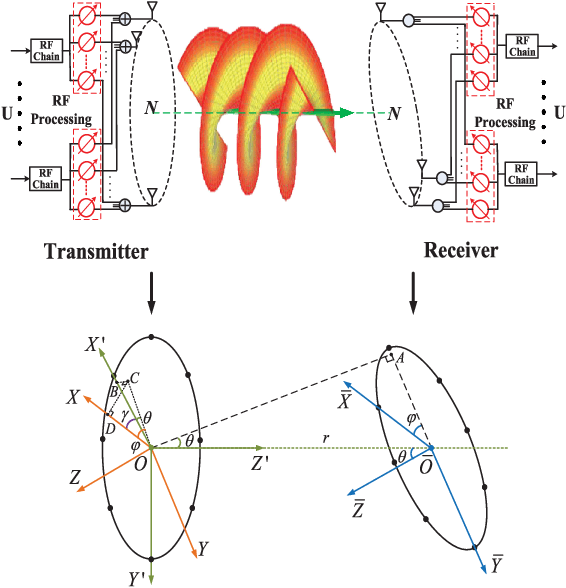

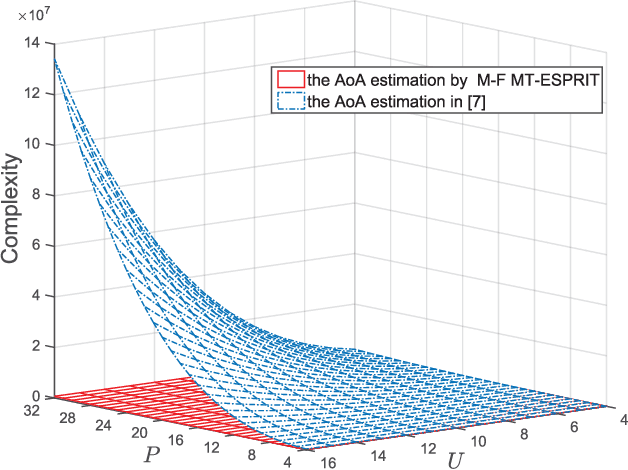
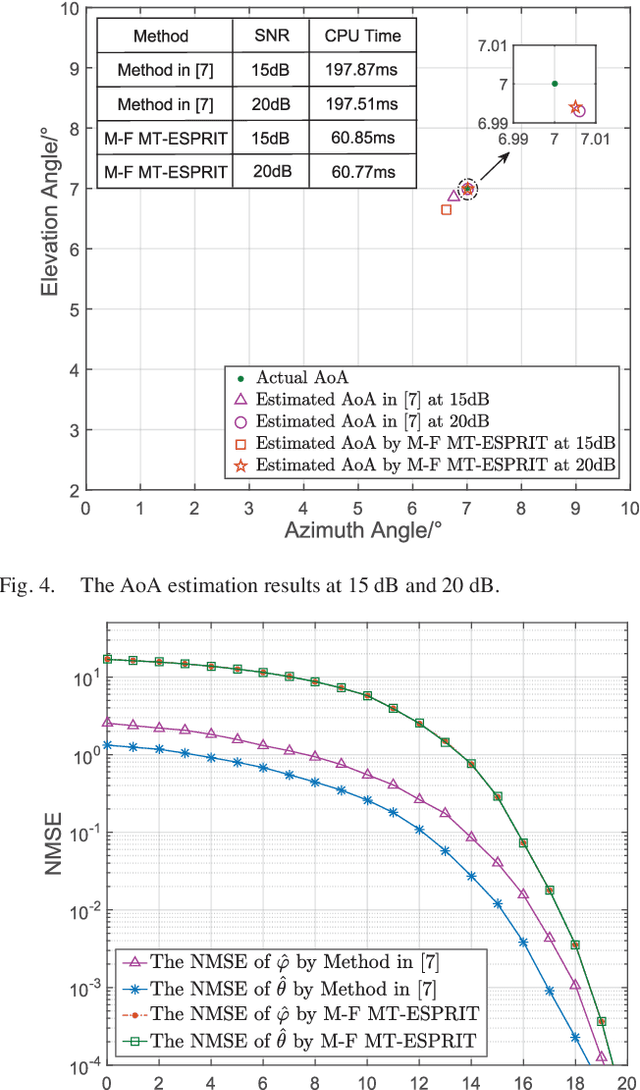
Abstract:Radio orbital angular momentum (OAM) communications require accurate alignment between the transmit and receive beam directions. Accordingly, a key feature of OAM receivers is the ability to reliably estimate the angle of arrival (AoA) of multi-mode OAM beams. Considering the limitations of existing AoA estimation techniques, in this paper, we propose an easier-to-implement AoA estimation method based on applying multiple times the estimating signal parameters via rotational invariance techniques (ESPRIT) algorithm to the received training signals in OAM mode and frequency domains, which is denoted as the mode-frequency (M-F) multi-time (MT)-ESPRIT algorithm. With this method, the misalignment error of real OAM channels can be greatly reduced and the performance approaches that of ideally aligned OAM channels.
 Add to Chrome
Add to Chrome Add to Firefox
Add to Firefox Add to Edge
Add to Edge